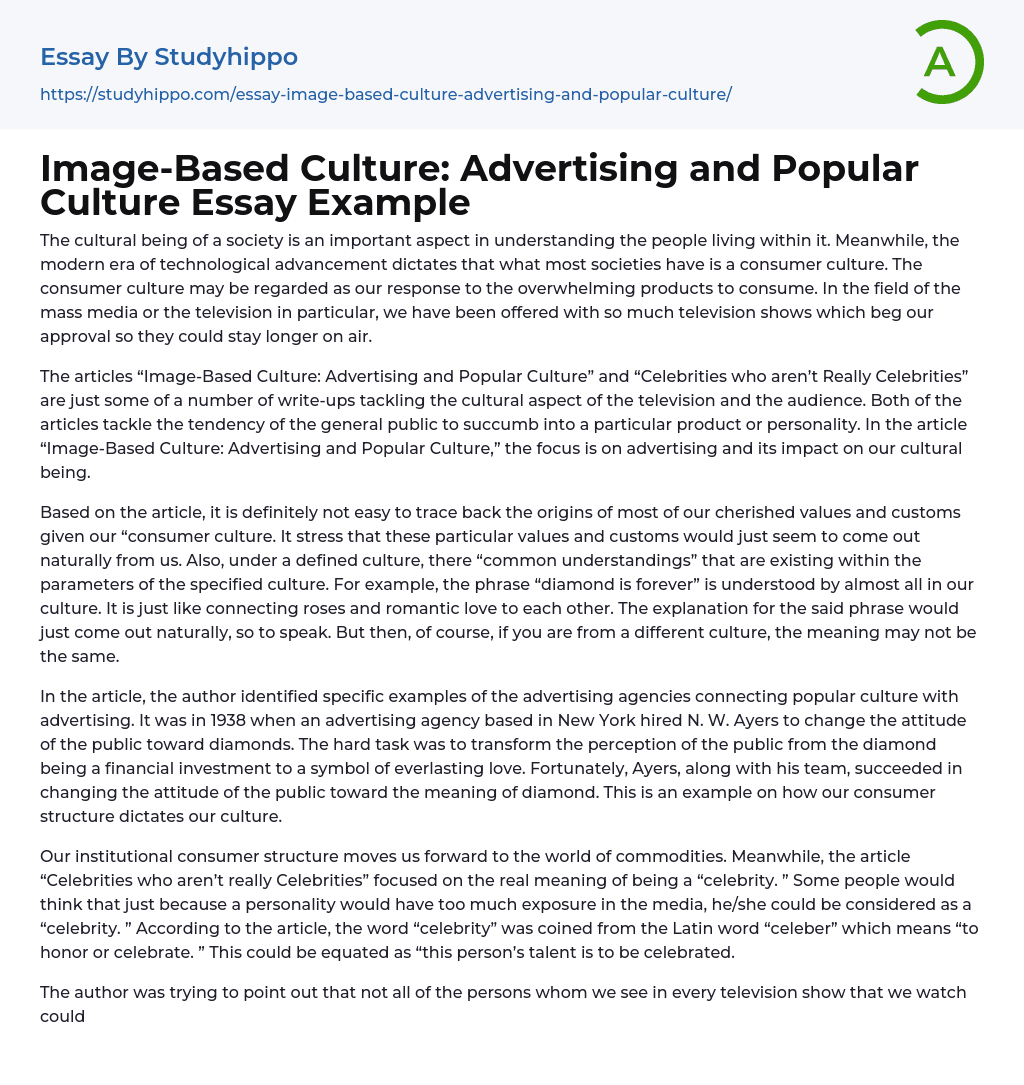

Image-Based Culture: Advertising and Popular Culture Essay Example
The cultural being of a society is an important aspect in understanding the people living within it. Meanwhile, the modern era of technological advancement dictates that what most societies have is a consumer culture. The consumer culture may be regarded as our response to the overwhelming products to consume. In the field of the mass media or the television in particular, we have been offered with so much television shows which beg our approval so they could stay longer on air.
The articles “Image-Based Culture: Advertising and Popular Culture” and “Celebrities who aren’t Really Celebrities” are just some of a number of write-ups tackling the cultural aspect of the television and the audience. Both of the articles tackle the tendency of the general public to succumb into a particular product or personality. In the article “Image-B
...ased Culture: Advertising and Popular Culture,” the focus is on advertising and its impact on our cultural being.
Based on the article, it is definitely not easy to trace back the origins of most of our cherished values and customs given our “consumer culture. It stress that these particular values and customs would just seem to come out naturally from us. Also, under a defined culture, there “common understandings” that are existing within the parameters of the specified culture. For example, the phrase “diamond is forever” is understood by almost all in our culture. It is just like connecting roses and romantic love to each other. The explanation for the said phrase would just come out naturally, so to speak. But then, of course, if you are from a different culture, the meaning may not be the same.
In the article, the author
identified specific examples of the advertising agencies connecting popular culture with advertising. It was in 1938 when an advertising agency based in New York hired N. W. Ayers to change the attitude of the public toward diamonds. The hard task was to transform the perception of the public from the diamond being a financial investment to a symbol of everlasting love. Fortunately, Ayers, along with his team, succeeded in changing the attitude of the public toward the meaning of diamond. This is an example on how our consumer structure dictates our culture.
Our institutional consumer structure moves us forward to the world of commodities. Meanwhile, the article “Celebrities who aren’t really Celebrities” focused on the real meaning of being a “celebrity. ” Some people would think that just because a personality would have too much exposure in the media, he/she could be considered as a “celebrity. ” According to the article, the word “celebrity” was coined from the Latin word “celeber” which means “to honor or celebrate. ” This could be equated as “this person’s talent is to be celebrated.
The author was trying to point out that not all of the persons whom we see in every television show that we watch could be considered as a celebrity. Basically the author was trying to voice out that there actually personalities who are actually running after media exposure because they need it “to stay alive. ” Along with the frequent exposure of the personalities who hunger for such is the perception of the public that these persons are celebrities. Both of the articles tried to discuss the consumer culture of the viewing public. Both of the articles
dwelled on the impact of the television on the cultural being of the viewing public.
As stated by both articles, the “consumer characteristic” of the general public plays a very crucial role in shaping the cultural set-up of a society. What is said to be “popular” is to be followed by the biggest fraction of the public. Thus, that trend would eventually be part of the society’s culture. Television is a very powerful tool in changing the attitudes of the general public toward certain things and issues. Given the number of population who are succumb to television shows and advertisements; it is not surprising that what is seen on the television would eventually enter the cultural structure of a society.
- Sales Promotion essays
- Advertising campaign essays
- Advertisement essays
- Advertising essays
- Anheuser-busch essays
- Audience Theory essays
- Brand essays
- Brands essays
- Competitor Analysis essays
- Consumer essays
- Detergent essays
- Marketing Management essays
- Marketing Mix essays
- Marketing Plan essays
- Marketing Research essays
- Marketing Strategy essays
- New Product Development essays
- Point Of Sale essays
- Price essays
- Procurement essays
- Product essays
- Product Differentiation essays
- Product Placement essays
- Promotion essays
- Promotion And Marketing Communications essays
- Research Design essays
- Retailing essays
- Trademark essays
- Actors essays
- Celebrity essays
- Magic essays
- Media essays
- Movies essays
- Music essays
- Roller coaster essays
- Television essays
- Video Game essays
- American Dream essays
- Barriers To Entry essays
- Capitalism essays
- Central Bank essays
- Compensation essays
- Consumerism essays
- Economic Development essays
- Economic Growth essays
- Economic Inequality essays
- Economic System essays
- Economy essays
- Employment essays
- Export essays



